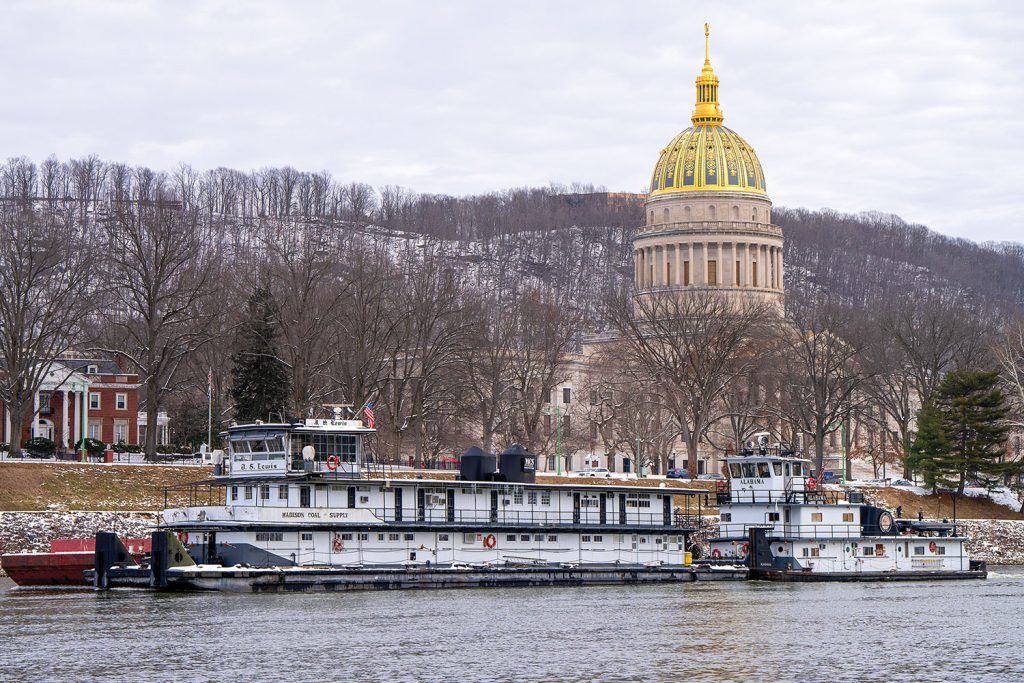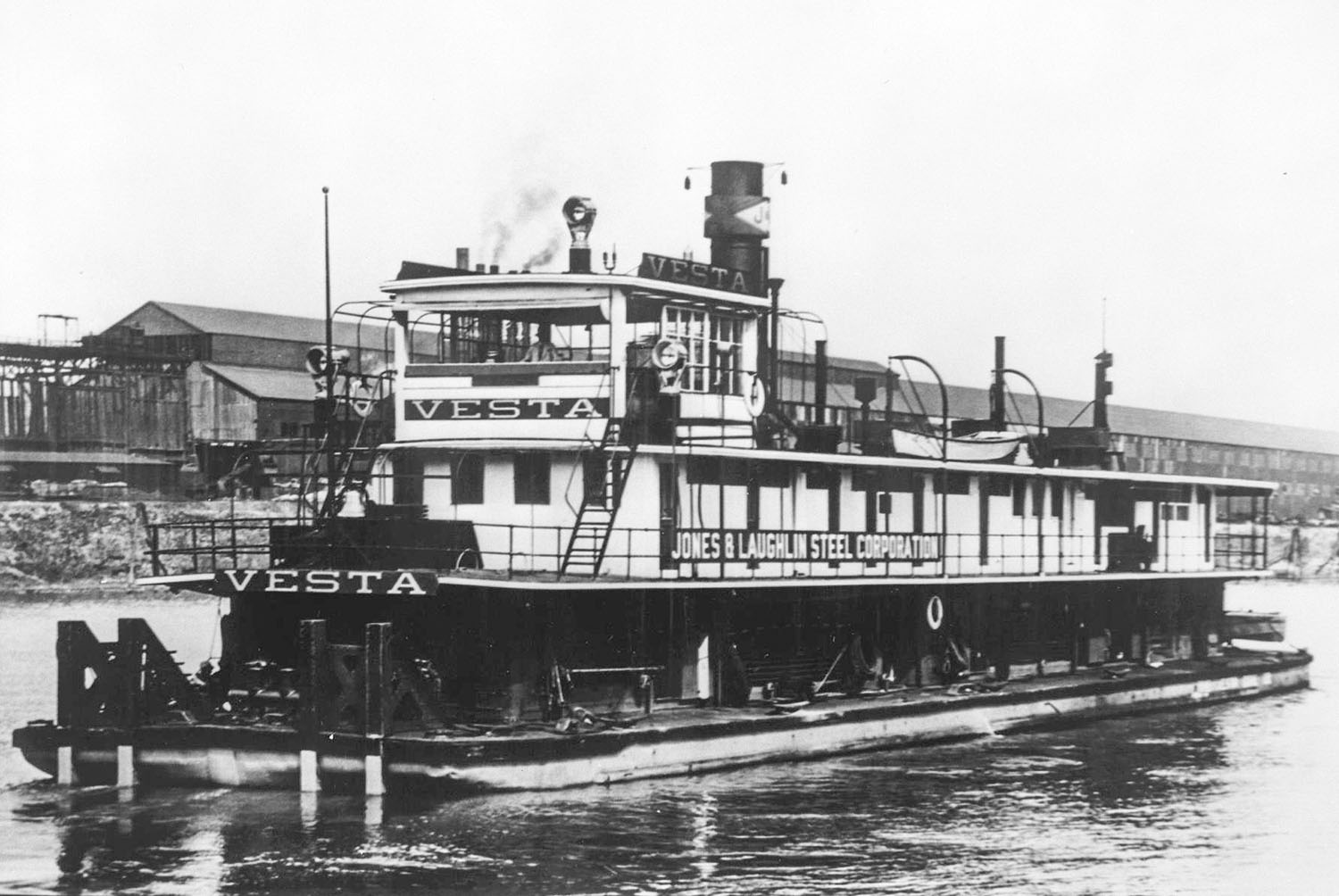The “stern line” rumor mill had been rumbling for some time, but on January 19 came confirmation that the venerable J.S. Lewis had changed owners for the first time in 70 years. The boat, detailed in this column in the March 27, 2023, issue of The Waterways Journal, is the oldest intact, operational line-haul towboat in existence on the inland river system.
The Lewis was built by the Charles Ward Engineering Works, Charleston, W.Va., in 1931 as the steam prop towboat Vesta for Jones & Laughlin Steel Corporation (J&L), Pittsburgh. It followed a duplicate vessel named Henry A. Laughlin, and the Vesta had the distinction of being the last vessel built by the Ward firm. It had a steel hull that was 155.3 by 29.5 by 9 feet. The triple-expansion condensing engines were 10’s, 17’s, 21 ¼’s by 18-inch stroke and were rated 750 total horsepower. The Babcock & Wilcox steam generators were coal-fired. The main deck cabin was of steel construction, with the upper cabin and pilothouse constructed of wood.
The Laughlin and Vesta were originally intended for Monongahela and Upper Ohio River service, and the news columns for Pittsburgh to Memphis in the WJ following the boats going into service made scant mention of them, so maybe they were in use towing coal primarily on the Mon. The Memphis news was often mentioning the big steam sternwheel boats of the J&L fleet, such as the Sailor (Way’s T2226), Titan (2443) and Wm. Larimer Jones (T2671), as delivering into the local terminals. However, by 1935 the two propeller steamers were the J&L mainstays in the Memphis run.
In 1948, J&L renamed the Vesta to honor the recently retired assistant superintendent of river transportation, James A. Rankin. In July 1952 both it and the Henry A. Laughlin were sold to The Ohio River Company. The Laughlin was renamed T.R. Workman, and the Rankin became the Mike Creditor. The Workman was dismantled in 1954, but the Creditor continued to operate, being renamed Orco in September of that year. In December 1954, the boat was sold to the Raleigh Junk Company, Sattes, W.Va., on the Kanawha River.
That firm contacted Charles T. Jones of Amherst Barge Company and asked if he would have any interest in the boat. He told them that he would, but since it was near Christmas would not be able to get a crew to it until after the holidays and if the steam piping or machinery froze up, he would no longer have interest. When they picked the boat up, nothing had frozen, but it was a huge mess because the scrap firm had placed oil-burning salamander heaters throughout to keep it warm.
Amherst named the boat J.S. Lewis and continued to operate it under steam until 1958, towing coal from the Kanawha River to Cincinnati. Photos of the boat underway, even as the Vesta, had always depicted it as quite a “smoker,” emitting a voluminous column of smoke from the single stack. The Smoke Inspectors office of the city of Cincinnati was very unhappy with the Lewis, particularly after it had caused all the lights on Columbia Parkway to come on in the afternoon. The decision was made to convert it to diesel, and the steam engines were replaced by a pair of Enterprise direct-reversing diesels coupled to 2:1 reduction gears. The horsepower then totaled 1,600.
Amherst placed its river equipment into the subsidiary company Madison Coal & Supply in 1970. In 1971, the company bought the Mike J from South Point Barge Company, built by Hillman in 1947, renaming it Charleston. The Charleston and the Lewis were the principal boats of the MCS fleet for many years thereafter.
I worked as pilot and captain aboard the Lewis a good bit during the early to mid-1980s. It was a great handling boat, despite the fact that it was direct reversible, and also steered well. There were some interesting times aboard it during high water. Capt. Ed Harris was master a lot of the times I was on it, and he was a joy to work with. Among others on it then were Capt. Steve Kimberlain, mate (now retired captain) Danny Harmon and engineers Tom Moore, Everett Brown, Ted Withrow and Butch Wills.
Madison Coal was merged into Amherst Madison in 2010, but prior to this the Lewis had become a spare boat. The simple 2:1 gears had been replaced by a set of Falk 2:1 gears with clutches, so the boat was no longer direct-reversing. It became well-known along the river system as it was utilized for many river industry public relations events, including the Tall Stacks at Cincinnati and towing the LST 325 and the Lewis & Clark re-enactors. It was usually open to the public at these events, and, as a result, tens of thousands of people have toured it. My own father, Edward “Smitty” Smith, would often be on it as engineer on these occasions, and later Tom DeHart, who very recently passed away, would serve as an engineer.
Capt. Charles T. Jones, longtime head of Amherst, passed away in October 2019, and in many ways the Lewis was laid to rest at the same time. The care of the boat was passionately overseen by Charlie, and he had it out running as often as possible. Without that passion the Lewis languished at its moorings at Port Amherst, above Charleston on the Kanawha River, and it began to suffer the effects of time. A new home was being sought for it, and in lieu of that the possibility of dismantling and scrapping loomed large.

When father and son Capts. Rick and C.R. Neale heard what the boat was facing, they contacted Amherst Madison and worked out a deal to purchase the historic vessel. Neale Marine Transportation has a rich history of its own, dating back to the late Capt. Charles Neale and wife Dianne purchasing Joe S Towing Company out of necessity just to be able to get their farming equipment out to Neale Island, Mile 182 Ohio River. From that one small towboat and a ferry flat, the company has grown now into the third generation with a wide array of marine equipment including a drydock and some 10 towboats.
The Neale family has always had a great appreciation for river history, and it is very welcome news that they will now be custodians of the 93-year-old J.S. Lewis, hopefully shepherding it into its second century of existence. The Lewis departed Port Amherst on January 22, in tow of the Amherst Madison towboat Alabama, for delivery to the Neale Landing at Parkersburg, W.Va.
Caption for top photo: As the Vesta for J&L Steel in a posed shot. Note that there is no sash in the front of the pilothouse. (David Smith collection)



